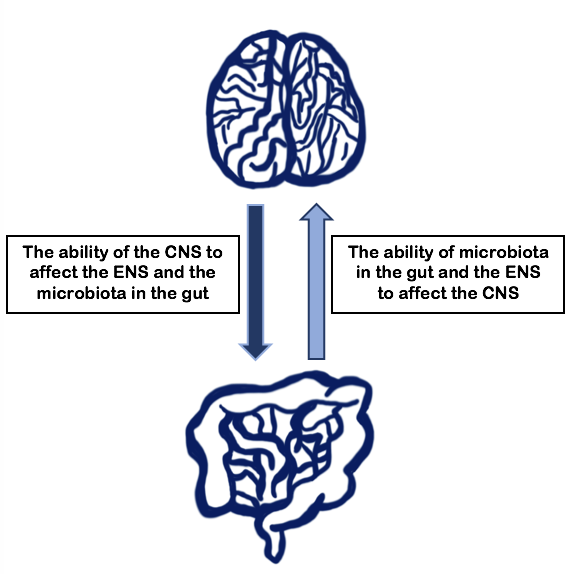Gold Medal and Integrated Practices
Collaborative efforts with local professionals in science, medicine and social work allowed us to shape our project in an ethical and effective manner. We focused our human integration efforts on analyzing potential solutions to a problem that directly impacts the Austin, Texas community. According to a 2009 CDC report, roughly 12 percent of the Austin population was diagnosed with a mental affliction compared to a 10 percent prevalence nation wide (1). Because mental health is a significant issue in our region, we aimed to focus our project on the treatment of mental health diseases.
Confirming Our Project Potential
As noted in Human Practices, outreach to professors at the University of Texas was paramount in the development of our project. After reading an article suggesting that GABA may have anxiolytic effects from bacteria within the gut (2), we were unsure of the mechanism that this could occur. It was our understanding that GABA is unable to, or can only minimally, pass the blood-brain barrier (3). We connected with Dr. Qingchun Tong, who has researched the influence of GABAergic systems on energy balance, for advice. He suggested that “..GABA may influence pancreas and gut function, which then in turn affects brain function through changes in hormones or other factors.” Essentially, he described the gut-brain axis. The gut-brain axis is a novel concept that describes the ability of our enteric nervous systems to communicate with our central nervous systems through neural and hormonal pathways (4). With confirmation that GABA might have significant effects on the central nervous system via the gut-brain axis, it became our molecule of interest.
Because GABA is inherently produced in small amounts by various Bifidobacteria and Lactobacill within the human gut (5), it seemed logical to enhance the GABA production of one of these species so our modified bacteria could proliferate in the gut. At this point, we chose to manipulate Lactobacillus plantarum. This species is present in the human gut, produces GABA in a significant capacity and it is relatively well characterized in comparison to other Lactobacillus strains (5, 6). Using Lactobacillus plantarum, we aimed to form a probiotic with an ability to produce therapeutic levels of GABA. This product could be packaged into a pill and used as medication or as a supplemental treatment for anxiety. Because the bacteria would have the ability to propagate in the gut, this probiotic could continue to produce therapeutic levels of GABA and have more potent and long-lasting effects than a GABA supplement.
How to Improve the Current Medical Marketplace
In addition to anxiolytic effects, there are proposed antihypertensive effects of GABA (3). We discussed this idea with Heart Hospital of Austin, also known as Austin Heart, in order to learn how a product like this might fit into the current marketplace of hypertensive medication. Austin Heart was very helpful and supportive of the project. They explained that often times barbiturates have many negative side effects, such as inhibiting gut motility. GABA regulates gut motility (2), so this issue would be rectified with our proposed medication. However, the best advice they offered was to alter our delivery method. Dr. Roger Gammons said, “There is a lot of research into different types of drug delivery... There are situations where one drug may inhibit the absorption of another one because they may compete for the same pathway.. The treatment used is very specific to the patient. There are a lot of pills out there, but often times, that isn’t the best method.” We are working with bacteria, so our simple solution was to alter our original probiotic pill design into a fermentable food product that may be more beneficial for some patients. We felt that children may particularly benefit from this product because fermentable foods such as yogurt, or dark chocolate are typical in a child's diet, so this may prevent habitual pill consumption that may facilitate drug addiciton.
Drug Delivery and Dosage
The fermentable food product was discussed with Micki Marquardt from Helping Hand's Home for Children. We wanted to know if she had any advice on the idea of medicine in a food form. There may be a drawback of our proposed medication in that a child could potentially confuse the medicinal product with regular food, so packing would need to be explicit. Another concern is cell proliferation in the gut. This is one of the benefits of our design because the medication can work continuously rather than 24 hours like a typical medication would function. However, there is an increased risk of overdoseif the cells become too prolific. In order to address this, we propose to incorporate a regulation system using an altered agr quorum sensing system from Staphylococcus aureus. Through quorum-sensing, these bacteria would limit glutamate decarboxylase production after reaching a high population threshold. This high population threshold would be directly correlated with high levels of GABA, thus providing a density-dependent mechanism for GABA dosage. This addition to the project has not been developed, but remains a future goal that we intend to work on after the iGEM competition.
References
- 9Psychological Distress. (2013, October 04). Retrieved September 08, 2017, from https://www.cdc.gov/mentalhealth/data_stats/nspd.html
- 2Hyland, N. P., & Cryan, J. F. (2010). A Gut Feeling about GABA: Focus on GABA Receptors. Frontiers in Pharmacology, 01. doi:10.3389/fphar.2010.00124
- 5Gammons, R. (2017, June 21). Cardiologist Perspective [Telephone interview].
- 6Eisen, J. S. (2013). Faculty of 1000 evaluation for Gut-brain axis: how the microbiome influences anxiety and depression. F1000 - Post-publication peer review of the biomedical literature. doi:10.3410/f.718013229.793477291
- 7Yunes, R., Poluektova, E., Dyachkova, M., Klimina, K., Kovtun, A., Averina, O. Danilenko, V. (2016). GABA production and structure of gadB / gadC genes in Lactobacillus and Bifidobacterium strains from human microbiota. Anaerobe, 42, 197-204. doi:10.1016/j.anaerobe.2016.10.011
- 8Nguyen, T., Kang, J., & Lee, M. (2007). Characterization of Lactobacillus plantarum PH04, a potential probiotic bacterium with cholesterol-lowering effects. International Journal of Food Microbiology, 113(3), 358-361. doi:10.1016/j.ijfoodmicro.2006.08.015



